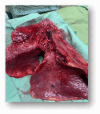Successful bilateral lung transplantation in pulmonary alveolar microlithiasis: A case report and review of literature
- PMID: 38725329
- PMCID: PMC11082537
- DOI: 10.1111/crj.13773
Successful bilateral lung transplantation in pulmonary alveolar microlithiasis: A case report and review of literature
Abstract
Background: Pulmonary alveolar microlithiasis (PAM) is a rare autosomal recessive genetic disorder with approximately 1000 known cases worldwide, in which calcium phosphate microliths deposit in the alveolar air spaces. As of writing this report, no definitive conventional therapy exists, and many PAM cases may progress to severe respiratory failure and potential death. Bilateral lung transplantation (BLx) seems to be the most optimal solution; however, this procedure is challenging along with limited reports regarding the outcome in PAM. We report a case of PAM successfully treated with BLx for the first time in Iran.
Method: We present the case of a 42-year-old female with a longstanding history of cough, not responding to conventional antitussive medication, who was diagnosed as a case of PAM following a hospitalization due to coughing, dyspnea on exertion, and hemoptysis. Despite treatment with corticosteroid and medical treatment, no improvement was achieved and she subsequently developed respiratory and right ventricular failure, with oxygen ventilation dependence. Eventually, she was scheduled for BLx. The operation was successful and during her 2-year follow-up, no recurrence or significant postoperative complications has been reported.
Conclusion: This case presentation and literature review confirm the effectiveness of BLx as a promising treatment for PAM-diagnosed patients, improving both life expectancy and quality of life.
Keywords: cough; dyspnea; lung transplantation; pulmonary alveolar microlithiasis.
© 2024 The Authors. The Clinical Respiratory Journal published by John Wiley & Sons Ltd.
Conflict of interest statement
The authors declare that they have no competing interests.
Figures







References
Publication types
MeSH terms
Supplementary concepts
LinkOut - more resources
Full Text Sources
Medical
Research Materials
Miscellaneous

